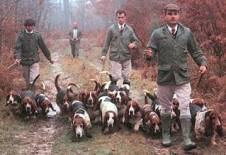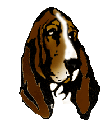|
Bonjour! Well that is how the original
Basset Hounds would have greeted you! Just a little information about
our involvement in this breed. It all started with the movie "The
Rage: Carrie 2" In this version of the movie the "anti-heroine" had
this beautiful Basset Hound whose name was Walter. he didn't have a very
big part in the flick but was very much love by the character Emily Bergl
was portraying. I feel in love with this dog. At that time I was not showing
dogs and was deeply involved in Maine Coon cats. It would be at a cat
show in Albuquerque, New Mexico where I would meet and become close friends
with a breeder/judge of Basset hounds. Another 5 years would pass before
our Bratey became a gift to our son who was turning five years old. i
remember the day Bratey a friend went with me to pick Bratey up from the
breeder's home and we raced from the mountains all the way back into town
to take Bratey up to school to be the surprise for our son at his classroom
I remember the day that Bratey finally came home to us. A very dear friend at the time went with me up to Edgewater, NM to the Breeders home. After all the formalities of taking possession, we raced back down from the mountains
so that I could surprise my son Joshua when class was letting out (Joshua was in Kindergaten).
Trust that Bratey was a BIG HIT at the school and with Joshua.
It wasn't long before I had changed
my mind about not showing dogs anymore and was asking our close friend
about getting another Basset Hound from him. This time as luck would have
it, we got our Maggie ( Pas de Deux ) around our son's birthday again.
Our then mentor was so very fond of our son and these two gifts were absolutely
precious and dear.

What is a Basset Hound???
The Basset Hound is a long, low, scenting hound of French ancestry. His
many admirers consider him to be among the most beautiful and unusual
of all hounds, his dignified look owing in great part to a large, majestic
head adorned with long, velvety ears, a wrinkled brow and dark, soulful
eyes. The Basset Hound remains one of the most easily recognizable of
all dog breeds.
The Basset Hound originated
in sixth-century France, a country known for its many strains of hounds.
Most strains had a tall version as well as a short-legged size under sixteen
inches, which were called “basset” (bas in French means low-set). Both
the Basset Hound and its long-legged cousin, the Bloodhound, are thought
to be descendants of the famed St. Hubert hounds. St. Hubert, a churchman,
was the patron saint of the hunt, who set out to develop a new strain
of hound, which looked similar to today’s Bloodhound. Many authorities
feel the Basset was a result of a mutation in the St. Hubert strain. This
genetic deviation produced a short-legged, dwarfed hound, whose slower
movement and low-set form was to prove useful for hunters on foot in search
of small game. With his long ears helping to stir up the scent, packs
of Bassets were used to drive small prey, such as rabbit and hare, from
dense undercover into open terrain where hunters could move in for the
kill with spears, nets or clubs. The sport of pack hunting with Basset
Hounds continues to this day in France and England.
Understanding the Basset Hound
Despite a deliberate, unhurried
manner and captivating and clownish demeanor, the Basset Hound possesses
great intelligence and what may often be viewed as stubbornness may more
appropriately be attributed to an innate ingenuity. In fact, the Basset
excels at getting his way, from “demanding” a tasty morsel at the table
to hurling his hefty 65 pounds into your lap! His overly long body, short
legs and delightful wrinkles become a kaleidoscope of amusing expressions,
all cleverly orchestrated to win us over. And win us over he does. Gentle
and sociable in nature, the easy-going Basset Hound is loyal to master
and family, devoted to children and mild-mannered and friendly towards
other animals
Physical Traits & The Basset Hound Personality
- Calm, good-natured and affectionate. Gets along well with people
and other dogs and pets. Good with children. Loves to be a lap dog.
Not a good guard dog.
- Sensitive and stubborn nature. A Basset takes punishment and reprimands
to heart. Can be stubborn and conveniently “hard of hearing.”
- Pack mentality. A single Basset may not do well left alone for long
periods. For working owners, the company of another dog is the next
best thing to having you there.
- A scent hound. The Basset was bred to trail game. His keen nose can
lead him into dangerous situations such as the path of a speeding car
or an unfenced swimming pool. The Basset is safest in a secure, enclosed
area.
- Relatively low activity level. Prone to obesity. Healthy, trim Bassets
have good energy levels, but they are also content to snooze away the
afternoon in a patch of warm sun. Although this laid back nature makes
them desirable house pets, their weight must be kept in check. A daily
walk with your Basset is recommended.
- A large, hefty dog, possessing more bone for its size than any other
breed of dog. Although Bassets are low to the ground, they are not small
dogs, with most ranging from 50 to 65 pounds. The average person will
have a difficult time lifting an adult Basset Hound.
- A smooth-coated dog. A wash-and-wear dog who may be bathed as frequently
as needed. Bassets are either tri-colored (a combination of black, white
and tan) or red-and-white (a lighter red-and-white may be called lemon-and-white).
Coat colors are distributed over the body in no particular pattern.
- Growing puppies have special needs. Until they are a year old, Basset
puppies should not go up and down long flights of stairs or be allowed
to jump on and off elevated objects such as couches, beds or porches.
The joints of this heavy-boned breed are still forming and excessive
stress or strain may cause permanent injury. After a year of age, these
activities, within reason, are usually not harmful to your Basset.
- Short legs may mean a needed boost! Many, but not all, sturdy, low-slung
Basset Hounds may require assistance getting into a car. The unique,
low-stationed Basset does not excel at jumping.
- Long ears and droopy eyes need cleaning. Nails need trimming. The
long ears of a Basset do not allow good circulation of air and are prone
to infection. Owners should clean their dog’s ears once a week. The
Basset’s droopy eyes should also be kept clean of debris and nails trimmed
once or twice monthly
|

